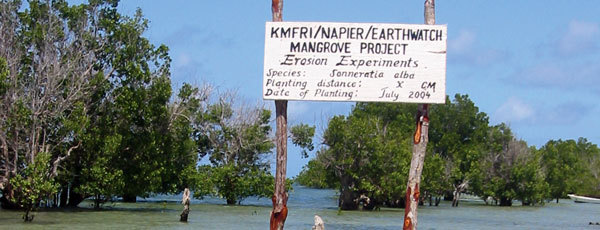Managing Mangroves and Capturing Carbon in Kenyan Communities
- Mombasa, Kenya
- Volunteer Vacations

| from $2,495* per person | 11 Days | July |
| Simple accommodations | Exertion level: 4 | |
| Operator: Earthwatch Institute | 10 people max | |
Loading map, please wait...
Locations visited/nearby
Gazi Bay , Kwale District , mangroves , woodlands , scientific research , wildlife survey , animal behavior , wildlife protection , Kenya
0 testimonials about this trip.
1 testimonial about the provider, Earthwatch Institute:
-
Reviewer: L. Reifschneider
located in
St. Louis,
MO
USA
Elephant conservation is what drives my travel destinations. However, I always come home counting the blessings of new friends and an understanding of a culture and way of life I possibly would otherwise have never been introduced to. Through the Earthwatch projects I participate in, I am learning just how big and wonderful this world is.
Itinerary
On the ExpeditionHelp restore important mangrove ecosystems.
You will live and work with local villagers to help conduct pioneering plantation experiments to rehabilitate degraded mangroves in Gazi Bay. In addition to planting mangrove seedlings on our two beach sites, you will also help monitor the effects of these plantations on rates of beach erosion and on the animals, particularly crabs and fish, dependent on them. The results will benefit the local fishing community, which relies on mangrove forests for wood products and fish habitat. You will also contribute to global efforts to restore dwindling mangrove forests and combat the effects of rising sea levels, as well as provide applied data on the use of mangrove forests as carbon sinks. On your recreational day, you can visit Kisite-Mpunguti Marine National Park, watch dolphins, and tour historical sites.
Meals and Accommodations
Your team will live in Gazi Village, staying in a shared village house, getting to know the village and immersing yourself in Kenyan culture. The houses have toilets and electricity, and provide bedding and mosquito nets. A cook will provide local food, including coconut curries and fresh seafood. Gazi Village is a quiet village, home to about 1000 people, and is close to beautiful beaches and impressive bird life.
About the Research Area
Gazi Bay, in the Kwale district of Kenya, is located 55 kilometers (34 miles) south of Mombasa. The bay has a surface area of 18 square kilometers (6.9 square miles) and is sheltered from strong sea waves by the presence of Chale Peninsula to the east and a fringing coral reef to the south. The reef supports a local subsistence and commercial fishery, with catches being landed on the main beach in the bay. On the landward side, Gazi Bay is bordered by 6.2 square kilometers (2.4 square miles) of mangrove forests. These forests are heavily used by local people as a fishing ground and a source of wood for building and fuel.
The bay area has beautiful beaches and impressive bird life, including three species of bee-eater, pelicans, palm vultures, and hornbills. It is near a black and white Colobus monkey reserve, the tourist resort of Diani beach, the Shimba Hills National Park (famous for its elephants) and the Kisite-Mpunguti Marine National Park (with dozens of dolphins, sea turtles and spectacular coral reef snorkeling). There are many sites of historical interest on the coastline, including a ruin in Gazi that was once used as a concentration center for slaves before they were shipped to Far East countries.
More information from Earthwatch Institute:
- View trip on provider's website
earthwatch.org/expeditions/managing-mangroves-and-capturing-c… - Company profile, experience, and history
- View all of their trips
- Email this trip page to a friend
-



Comments from Facebook